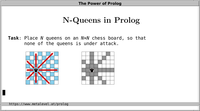Solving N-queens with Prolog
The task is to place N queens on an N×N chessboard in such a
way that none of the queens is under attack.
| Video: |

|
Prolog Solution
In the programming language Prolog, it is easy to
describe solutions of this task
using CLP(ℤ) constraints which are
commonly used
for combinatorial tasks:
n_queens(N, Qs) :-
length(Qs, N),
Qs ins 1..N,
safe_queens(Qs).
safe_queens([]).
safe_queens([Q|Qs]) :-
safe_queens(Qs, Q, 1),
safe_queens(Qs).
safe_queens([], _, _).
safe_queens([Q|Qs], Q0, D0) :-
Q0 #\= Q,
abs(Q0 - Q) #\= D0,
D1 #= D0 + 1,
safe_queens(Qs, Q0, D1).
|
|
Full code: queens.pl
You can
use Scryer
Prolog to try it. Start it with:
$ scryer-prolog queens.pl
You can then run queries like:
?- N = 8, n_queens(N, Qs), labeling([ff], Qs).
N = 8, Qs = [1,5,8,6,3,7,2,4]
; ...
?- N = 20, n_queens(N, Qs), labeling([ff], Qs).
N = 20, Qs = [1,3,5,14,17,4,16,7,12,18|...]
; ...
The n-th integer in the list denotes the row of the queen
that is placed in column n.
Animation
If you have the PostScript viewer "gs" installed, you can view an
animation of the
constraint solving process.
Here is an example shell command you can try:
$ scryer-prolog -g 'show(20,[ff])' queens.pl | \
gs -dNOPROMPT -g680x680 -dGraphicsAlphaBits=2 -r144 -q
The arguments of the predicate show/2 are:
- the number of queens
- a list of labeling options.
As a side-effect, you see an animation of the
constraint solving process.
Sample PostScript file, a self-contained saved animation
for 50 queens (open it with "gv" or "gs" to view
it): queens50.ps
Sample animation (requires JavaScript), showing 80 queens with labeling strategy ff: queens80.
Here is a picture of a finished animation:

Example with 100 queens:
Challenges: Find solutions for many queens. Find good labeling and
allocation strategies. ...
Further reading:
Neumerkel
at
al., Visualizing
Solutions with Viewers.
More CLP(ℤ) examples: https://github.com/triska/clpz
More about Prolog: The Power of Prolog
Main page





